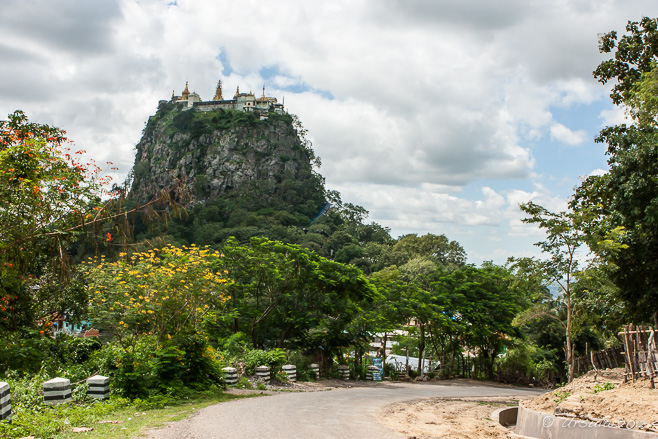
Temple on Taung Kalat – Pedestal Hill
Popa Taung Kalat Monastery sits high on top of a volcanic plug in the Mount Popa National Park. Traditionally, the Mount Popa area is the most important home of the Nats – Burmese spirits.
Nats (နတ်), or spirits, have been a central part of Burmese life since time immemorial.
Nats are everywhere in Myanmar: they are in the trees, the wind, the stones and the waterways. They act as personal and village guardians, but can be troublesome if not properly propitiated. Every Burmese village has a shrine to curry favour with the local Nats; ritualised offerings are hung in houses; amulets are worn; and car rear-view mirrors are festooned with talismans to ward off mischief. Festivals to appease the major Nats are held regularly.
Part of a rich heritage of early animist religions in the Burmese countryside, Nat worship predates Buddhism. When King Anawrahta of Bagan (1044–1077) first introduced Buddhism into Myanmar, he tried to ban the worship of the old spirits. However, his attempts backfired, and Nat worship was simply driven underground. Clever enough to recognise his failure, he decided to incorporate a hierarchical pantheon of 37 Great Nats – also known as the Mahagiri Nats – into the local Buddhist practice. The chief of these Nats is Thagyamin Nat (the Indian god Indra, protector of royalty) and the others are ghosts or spirits of dead Burmese heroes, many of whom were killed prematurely. All of these principal Nats are known nation-wide. They have their own personalities and histories; many have their own ceremonies and festivals. Nats are not saints or angels. They have the same human characteristics and flaws as they had in life, and they are often angry or jealous of the living. So, while the Burmese might ask the Nats for good fortune, they are also concerned with appeasing them to avoid harm.
Mount Popa, a long-extinct solitary volcano standing out from the dry plains of Central Myanmar, has long been designated home of the Nats. Four kilometres from the main peak is one of Myanmar’s most sacred places: Taung Kalat (Pedestal Hill), an incredible magma plug rising straight up some 170 – 180 meters from the surrounding rock and jungle. The Popa Taung Kalat Temple, a Buddhist monastery and pilgrimage site, including shrines to all 37 Nats, perches precariously on the summit.
I was travelling in the Mount Popa National Park area with Photo-Tour Leader Karl Grobl and local guide Mr MM. We didn’t climb the 777 steps to the monastery – much as I would have liked to. According to sources (including: Wondermondo: Popa Taung Kalat and National Geographic Voices: Mount Popa), the temple and shrines are fascinating and the views are stunning…
What we did do, however, was equally fascinating: starting with a visit the Mahagiri Shrine at the foot of Mount Popa.
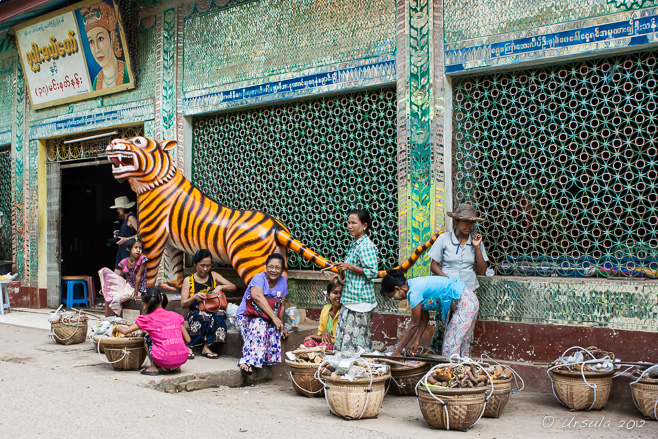
Mahagiri Shrine
Hawkers, with their baskets full of offerings for the spirits and snacks for the pilgrims, congregate out the front of the colourfully decorated Mahagiri Shrine – a temple at the base of Mount Popa dedicated to the 37 principal nats.
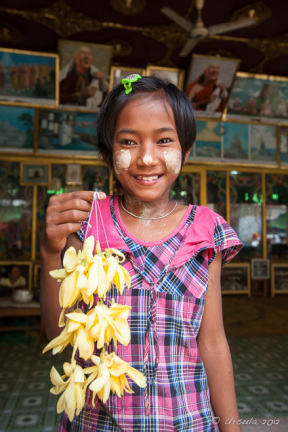
Flower Seller
Inside the Mahagiri Shrine, a young girl sells garlands, intended as offerings to the spirits.

Three of the 37 Nats
King Anawrahta of Bagan designated an official pantheon of 37 Great Nats.

Offering
Nats are very human in their desires: gifts to them include alcohol, cigarettes, goods, flowers, and money. Money they have blessed is considered especially lucky.

Locals on the Stoop
Rhesus macaques have run of the town of Popa.

Rhesus Macaque
Although very cute, the monkeys expect their share of “offerings”.

Rhesus Macaque

Popa Mountain Resort
We lunched at a wonderful resort …

Playing the Saung
… with traditional burmese harp music …

Temple on Taung Kalat (Pedestal Hill)
… and amazing views of the Buddhist temple that perches on the top of the volcanic plug at the Southwest of Mount Popa.
Each of the 37 Great Nats was, in at least one of their previous incarnations, associated with members of the royal family; Nat worship therefore, affords commoners some protection against misfortune.
As we discovered in a nearby rural village, it does not, however, bring electricity or running water.

Children at the Window
At a small school near Taung Kalat …

Teacher Marking
… children study and teachers work without the benefit of electric lights or fans.

Child at the Schoolhouse Window

Kids in the Classroom

Cow in the Barn
In spite of the lack of modern conveniences, this rural village is neat and tidy.

Man on the Stoop
The community has received a recent injection of funding, and some of the buildings are quite new.

Woman in the Barn
Workers always seem happy to take a moment out …

Chopping Grass
… from monotonous manual labour …

A Burmese Smile
… to flash a brilliant smile for the camera.

Old Burmese Man
A community elder pauses to take stock of the visitors …

Old Man
… and to pose.

Piglets in the Yard
A mainstay of any “rich” tropical community, pigs are the perfect grain-storage units in damp or rainy climates where grains grow mouldy quickly after harvest.

Young Girl
Not all the children are in school –

Village Children
– and those running loose in the dirt are happy to have their pictures taken.

Young Boy

On the Dirt Path
A woman from the village carries laden water buckets home in the afternoon light.
Although some people say that Nat worship is dying out, this is more true in the developed, urban centres. In fact, the many annual Nat Festivals are still well-attended – and it is easy to see why rural people would want some surety in their uncertain and labour-intensive days.
 It’s a hard life. I hope the Nats can help people make the necessary transitions into the modern world.
It’s a hard life. I hope the Nats can help people make the necessary transitions into the modern world.
‘Till next time.
Pictures:19September2012


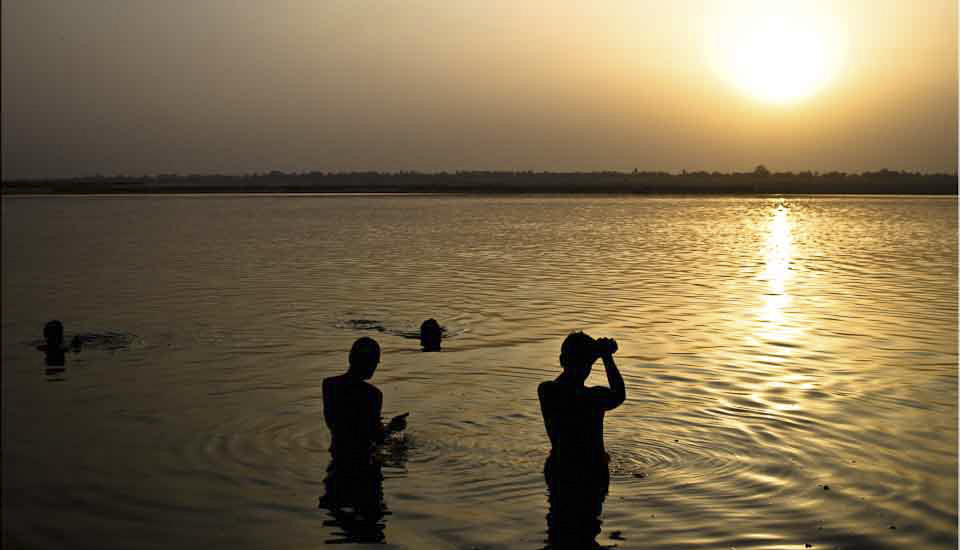





























.png)
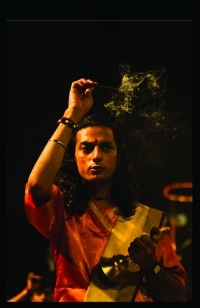
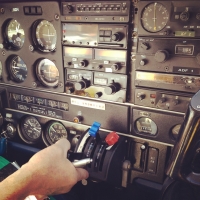
You nailed the story about the nats, Ursula – great photos & very informative
Thanks so much, Maureen and Karl.
The people in these wonderful places make photography such a delight, don’t they?
Happy Holidays!
Wonderful, wonderful, wonderful! Great job Ursula!
Nice report Ursula. Bagan a beautiful place, to see so much.
Warm greetings, Dietmut
Thanks, Dietmut!
Wonderful place, isn’t it? I loved every minute there. 😀
I can’t find info on how or who built it.
I’m not sure of the date, but it’s old! One legend goes back to the 6th century B.C, and Maung Tint Dai, a blacksmith in the Tagaung Kingdom.